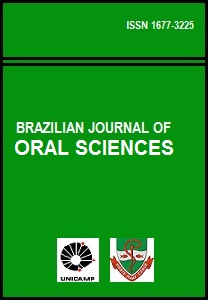Abstract
A decrease in caries experience among children has been observed in all countries. However, this subject has yet to be further investigated in adolescents. The aim of this study was to describe the prevalence and incidence of caries disease and determine possible factors associated to this condition among adolescents. A 2-phase longitudinal study was performed. The first phase comprised a prevalence study of caries carried out with children aged 11 to 13 years (n=247). The second phase was performed with the same participants at the ages of 15 to 17 years. DMF-T and Significant Caries Index (SiC) were used to assess dental caries experience. A logistic regression model analysis of data was performed. On the first phase, 69.23% of the subjects presented caries. The DMFT was 2.52 ± 2.54 and the SiC was 4.23 ±2.72. In the second phase, 88.26% of the subjects presented caries. The DMFT and the SiC were 5.27 ±4.10 and 10.58 ±3.13, respectively. Caries incidence was 2.94 ±3.05. The multivariate analysis identified that the individuals belonging to the most deprived social classes presented a 2.51-fold (1.22-5.19; p=0.012) higher chance of having experience caries (1st phase). The chance was 2.51-fold (1.21-2.55; p=0.013) higher in the 2nd phase. In conclusion, high caries prevalence and incidence were observed in the studied population and social factors were associated with these findings. Socioeconomic factors showed a direct association with caries experience.The Brazilian Journal of Oral Sciences uses the Creative Commons license (CC), thus preserving the integrity of the articles in an open access environment.
Downloads
Download data is not yet available.

